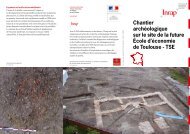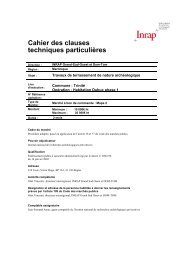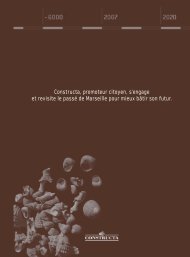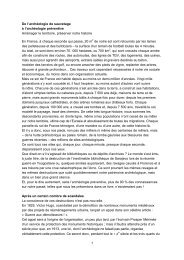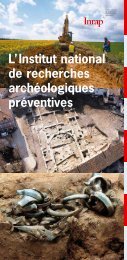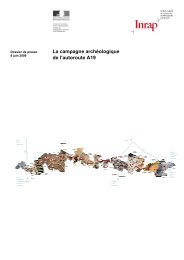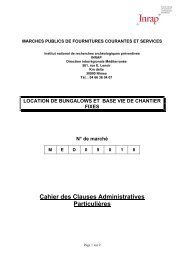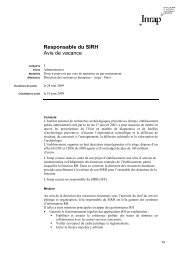Vestiges de la traite négrière - Inrap
Vestiges de la traite négrière - Inrap
Vestiges de la traite négrière - Inrap
You also want an ePaper? Increase the reach of your titles
YUMPU automatically turns print PDFs into web optimized ePapers that Google loves.
iNdiceS dU MarrONNaGe – 11 Mai 2012<br />
Le petit marronnage, une adaptation épisodique dans l’océan Indien :<br />
données <strong>de</strong> terrain et pertinence globale<br />
amitava chowdhury, Queen’s University, Kingston, Ontario<br />
Cette communication met en lumière les<br />
caractéristiques <strong>de</strong>s sites d’occupation <strong>de</strong>s<br />
esc<strong>la</strong>ves marrons à partir <strong>de</strong> travaux <strong>de</strong><br />
reconnaissance archéologique et <strong>de</strong><br />
fouilles à l’île Maurice. Le marronnage y<br />
est surtout caractérisé par <strong>de</strong>s sites<br />
d’occupation <strong>de</strong> courte durée, et il est à<br />
appréhen<strong>de</strong>r en termes d’adaptations<br />
épisodiques dans un contexte<br />
géographique aux horizons limités.<br />
D’importants sites d’habitation d’esc<strong>la</strong>ves<br />
marrons existaient à l’époque <strong>de</strong><br />
l’occupation hol<strong>la</strong>ndaise au xvii e siècle,<br />
mais ces sites ont disparu au cours <strong>de</strong>s<br />
occupations française et britannique <strong>de</strong><br />
l’île aux xviii e et xix e siècles. À leur p<strong>la</strong>ce,<br />
<strong>de</strong>s sites d’occupation <strong>de</strong> courte durée<br />
et <strong>de</strong>s gîtes d’étape, situés sur <strong>de</strong>s cimes<br />
montagneuses difficiles d’accès et dans<br />
<strong>de</strong>s tunnels <strong>de</strong> <strong>la</strong>ve souterrains, ont été<br />
construits un peu partout dans le paysage<br />
complexe <strong>de</strong> l’île. À partir <strong>de</strong> données<br />
issues <strong>de</strong> six sites fouillés, dont le morne<br />
Brabant, c<strong>la</strong>ssé au patrimoine mondial <strong>de</strong><br />
l’Humanité par l’Unesco, on peut établir<br />
<strong>de</strong>s schémas <strong>de</strong> reconnaissance <strong>de</strong>s formes<br />
à partir du cas particulier <strong>de</strong>s esc<strong>la</strong>ves<br />
marrons <strong>de</strong> l’île Maurice, avec <strong>de</strong>s<br />
résonnances globales pour le petit<br />
marronnage, particulièrement dans<br />
les petites îles <strong>de</strong>s Caraïbes.<br />
amitava chowdhury s’intéresse aux processus <strong>de</strong> <strong>la</strong><br />
formation <strong>de</strong> l’i<strong>de</strong>ntité dans <strong>la</strong> diaspora <strong>de</strong> l’Asie du Sud<br />
soumise à <strong>la</strong> servitu<strong>de</strong> pour <strong>de</strong>ttes aux Caraïbes et dans<br />
l’océan Indien. Il a travaillé sur l’archéologie historique <strong>de</strong>s<br />
sites d’esc<strong>la</strong>ves marrons et <strong>de</strong>s engagés à l’île Maurice.<br />
Son site archéologique <strong>de</strong> l’Aapravasi Ghat, un centre<br />
d’immigration pour travailleurs soumis à <strong>la</strong> servitu<strong>de</strong> pour<br />
<strong>de</strong>ttes à l’île Maurice, a été c<strong>la</strong>ssé au Patrimoine mondial<br />
<strong>de</strong> l’Humanité par l’Unesco en 2006. En juillet 2008, le site<br />
archéologique du morne Brabant, qui abritait <strong>de</strong>s esc<strong>la</strong>ves<br />
en fuite à l’île Maurice, a également été c<strong>la</strong>ssé au<br />
Patrimoine mondial.<br />
Bibliographie sélective<br />
• A. Chowdhury, Horizons of Memory: Indian In<strong>de</strong>ntured<br />
Labor and I<strong>de</strong>ntity in the Caribbean and the Indian Ocean<br />
in a Global Comparative Perspective, à paraître.<br />
• A. Chowdhury, “Marronage in Mauritius and its possible<br />
implications for Caribbean Archaeology” (avec C.<br />
Goucher), Proceedings of the Twenty-first congress of<br />
the International Association for Caribbean Archaeology,<br />
2007.<br />
• A. Chowdhury, “Marronage in Mauritius”, Encyclopedia of<br />
S<strong>la</strong>ve Resistance and Rebellion, Greenwood Publishing<br />
Group, Westport, 2007.<br />
• A. Chowdhury, “The symbolic and archaeological<br />
significance of Le Morne Brabant: A fugitive s<strong>la</strong>ve site of<br />
Mauritius”, Journal of Indian Ocean Archaeology 3, 2006.<br />
• A. Chowdhury, Aapravasi Ghat: Past and Present:<br />
Archaeological Investigations, Aapravasi Ghat Trust Fund,<br />
Port Louis, 2003.<br />
• A. Chowdhury, “Towards an Archaeological Heritage<br />
Management of Aapravasi Ghat”, Journal of Mauritian<br />
Studies, 2003.<br />
• A. Chowdhury, “Theoretical Reflections on Maroon<br />
Archaeology in Mauritius”, Revi Kiltir Kreol, 2003.<br />
33



